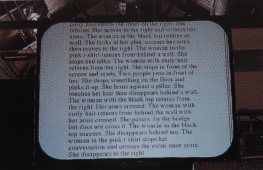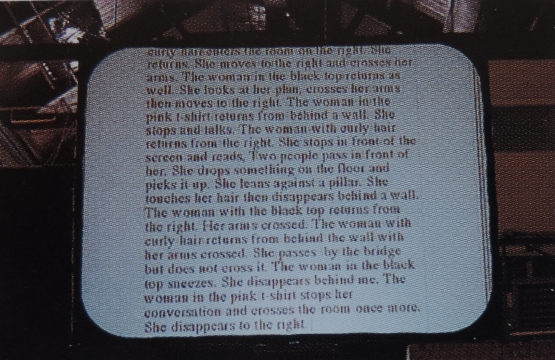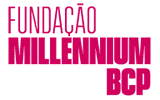Drawing a Rectangle
In the installation , i. e., video and drawing co-exist rather curiously in the engendering of the same form. On a white wall sits a charcoal drawing of a rectangle. Superimposed on the drawing is a video projection - a recording of the execution of the drawing. That's it! However, on closer inspection several questions emerge that complicate what seemed to be a simple equation. What we are looking at is not a drawing of a rectangle and a superimposed video projection documenting its making. Nor are we faced with the simple succession of filmed motions aiming for the completion of a drawing.
The video and the drawing are the traces of one and the same framing gesture, separated by an absence where a dialogue takes place. In this process time plays a critical role, and it is on this issue that we should focus our analysis.In this work the temporal relation between the drawn rectangle and the documentary of the rectangle is extremely ambiguous; the chronological order of making, of being, is not immediately clear. Initially, one might suppose that the video-rectangle would have been made before the drawing of the rectangle. However, our eyes tell us that the traces drawn by the artist are already inscribed on the wall, as if the past existed in the future. On the other hand, the presence of the drawn rectangle on the wall - that which may belong to the future and which represents the completion of the gesture that the video records - exists prior to its own making, as if the future might happen before the past. When recognizing these paradox we may then realize why the relationship between the video and the drawing is not one of cause and effect - rather, the presence of an absence to which the inscription of a sign is subjected to.
Moitinho has worked with this process of discontinuity in previous work most notably a recent installation at Tramway, in Glasgow. This piece, Untitled, so far initiated a gentle confrontation between the artist and the viewer; Moitinho sat at a table, on a low platform, or stage, and spent the day typing into his computer, making descriptions of what he saw happening in the exhibition space. At the same time an image of what he is writing on his computer was projected on to another screen placed high above the exit door, leading out of the space. In this way, the viewer has access to the artist's writings, his observation, but only after walking away from the place where the observation are taking place. In order to read the observations of the artist, the viewer must disassociate them from the image of the artist. Even further disassociated is a third component of the work; a fax machine, placed at another strategic point in the exhibition space, that pours forth an endless roll of paper inscribed with those same descriptions that have been written by the artist, and read by the viewer.
In a way, what we experience in Untitled, so far is the dissociation of a perceptive unity by means of a de-synchronization of the present. In , i. e., a similar problem is triggered, but here by the simultaneous existence of the video and the drawing of the rectangle.
Between the drawing's material and luminous existences, and in consequence of the temporal relationship established, both presences become virtualities of the meaning that actually exceeds them. The meaning is thus an absence, therefore, drawing and video are the respective actualization, condemned to virtuality, quite apart from any cause and effect relationship.
The body is a third element added by the video. It lives interposed between the rectangle' and its projection, continually testing the limits of this rectangle, it appears and disappears, exceeding the visible which the video projection and the drawing define and, primarily, contextualizes the meaning of the rectangle itself.
In 1997 Moitinho made a video work - Game for left hand - for the Fondazione Antonio Ratti in Como, in which we could see the motion of a hand embroidering some fabric sewing the fingers themselves. It was shown on a monitor placed on the floor of a room with frescos on the wall and where large drapes were placed on top of one another. The engagement of the body in defining a territory that , i. e. explores has occurred in the artist's previous works. Here, its existence is over the limit, it is confused with it and questions it. In this work the drawn rectangle is the physical limit of the video camera. This way the limit, being a prior element - the video projection - is overcome by the body that inscribes it on the shape of an irregular rectangle. The drawing and the video become the traces of act of inscription. The irregularity and repetition underline the body's confinement to a territory that the body assumes, but that at the same time does not belong to.
If we try to find a meaning in, or for , i. e., then perhaps we might read it as an indication of an impossibility; that is to say the impossibility of a territory, of a rectangle.
Pedro Lapa











